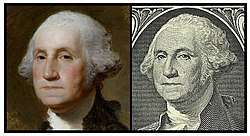George Washington's teeth
American President George Washington's teeth began to fall out before he reached the age of 30, and he eventually lost them all. During his lifetime, he had at least 4 sets of dentures made to replace them.
.jpg)
Natural teeth
In 1756, when Washington was 24 years old, a dentist pulled his first tooth.[1] According to his diary, he paid 5 shillings to a "Doctr Watson" for the removal. His diary also regularly mentioned troubles such as aching teeth and lost teeth.[2] John Adams says he lost his teeth because he used them to crack Brazil nuts but modern historians suggest mercury oxide, which he was given to treat illnesses such as smallpox and malaria, probably contributed to the loss.
On April 30, 1789, the date of his presidential inauguration, although he had mostly dentures, he had only one remaining natural tooth, a premolar.[3] During that same year, he began wearing full dentures.
Washington's last tooth was given as a gift and keepsake to his dentist John Greenwood.[4]
Dentures

During his lifetime, Washington had four sets of dentures. He began wearing partial dentures by 1781.[4] Despite many people believing they were made of wood, they contained no wood. They were actually made of other materials such as hippopotamus ivory, brass, gold, and human teeth possibly harvested from the people he enslaved.[5][6] The dentures had metal fasteners, springs to force them open, as well as bolts to keep them together.
He took the oath of office while wearing a special set of dentures made from ivory, brass and gold built for him by dentist John Greenwood.[5]
It is possible that he had a set made with real human teeth,[7] likely ones he purchased from "several unnamed Negroes, presumably Mount Vernon slaves" in 1784.[8]

According to his diaries, Washington's dentures disfigured his mouth and often caused him pain, for which he took laudanum.[9] Washington once wrote that his lips would "bulge" in an unnatural way. This distortion is noticeable on his image on the one-dollar bill, an image taken from the Athenaeum Portrait, a 1796 unfinished painting by Gilbert Stuart.[5] He once wrote to his dentist, Greenwood, to avoid modifying the dentures "which will, in the least degree force the lips out more than now do, as it does this too much already."[10] Apart from the disfiguration caused by the dentures, the distress may also be apparent in many of the portraits painted while he was still in office.[9][11][lower-alpha 1] He spent constant effort maintaining his dentures, and often had them shipped to Greenwood, for maintenance.[1]
The mistaken belief that Washington's dentures were wooden was widely accepted by 19th century historians and appeared as fact in school textbooks until well into the 20th century. The possible origin of this myth is that the ivory teeth quickly became stained and may have had the appearance of wood to observers. A letter from Greenwood to Washington in 1798 advised more thorough cleaning since: "the sett you sent me from Philadelphia...was very black...Port wine being sower takes of[f] all the polish".[12]
The only existing complete set of Washington's dentures are owned by the Mount Vernon Ladies' Association, who own and operate George Washington's estate in Fairfax County, Virginia. There is another complete, original, lower jaw denture dated 1795 at the National Museum of Dentistry, Baltimore, Maryland.[13]
Dentists

At least three of Washington's dentists are identified. His diary mentions "Doctr Watson", the dentist who pulled his first tooth. His personal dentist and friend was Jean-Pierre Le Mayeur.[5] John Greenwood of New York City made and maintained his dentures.[5]
Notes
- The Smithsonian Institution states in "The Portrait—George Washington: A National Treasure" that:
- Stuart admired the sculpture of Washington by French artist Jean-Antoine Houdon, probably because it was based on a life mask and therefore extremely accurate. Stuart explained, "When I painted him, he had just had a set of false teeth inserted, which accounts for the constrained expression so noticeable about the mouth and lower part of the face. Houdon's bust does not suffer from this defect. I wanted him as he looked at that time." Stuart preferred the Athenaeum pose and, except for the gaze, used the same pose for the Lansdowne painting.[9]
References
- Sun, Jed Kirschbaum / The Baltimore (27 January 2005). "George Washington's false teeth not wooden". msnbc.com.
- "George Washington's Teeth". George Washington's Mount Vernon.
- Schultz, Colin. "George Washington Didn't Have Wooden Teeth—They Were Ivory". Smithsonian.
- Pappas, Stephanie; March 3, Live Science Contributor; ET, 2018 08:07am. "What Were George Washington's Teeth Made Of? (It's Not Wood)". Live Science.
- Andrews, Evan. "Did George Washington have wooden teeth?". HISTORY., probably slaves.
- Dentures, 1790–1799 Archived 2014-04-13 at the Wayback Machine, George Washington's Mount Vernon Estate, Museum and Gardens
- Mary V. Thompson, "The Private Life of George Washington's Slaves", Frontline, PBS
- "The Portrait—George Washington:A National Treasure". Smithsonian National Portrait Gallery. Retrieved January 21, 2011.
- "FACT CHECK: Did George Washington Have Wooden Teeth?". Snopes.com.
- Stuart, Gilbert. "George Washington (the Athenaeum portrait)". National Portrait Gallery. Archived from the original on December 5, 2011. Retrieved December 18, 2011.
- Etter, William M. "George Washington's Teeth Myth". www.mountvernon.org. Mount Vernon Ladies' Association. Retrieved 24 March 2019.
- https://affiliations.si.edu/de-aging-george-washington/
External links
